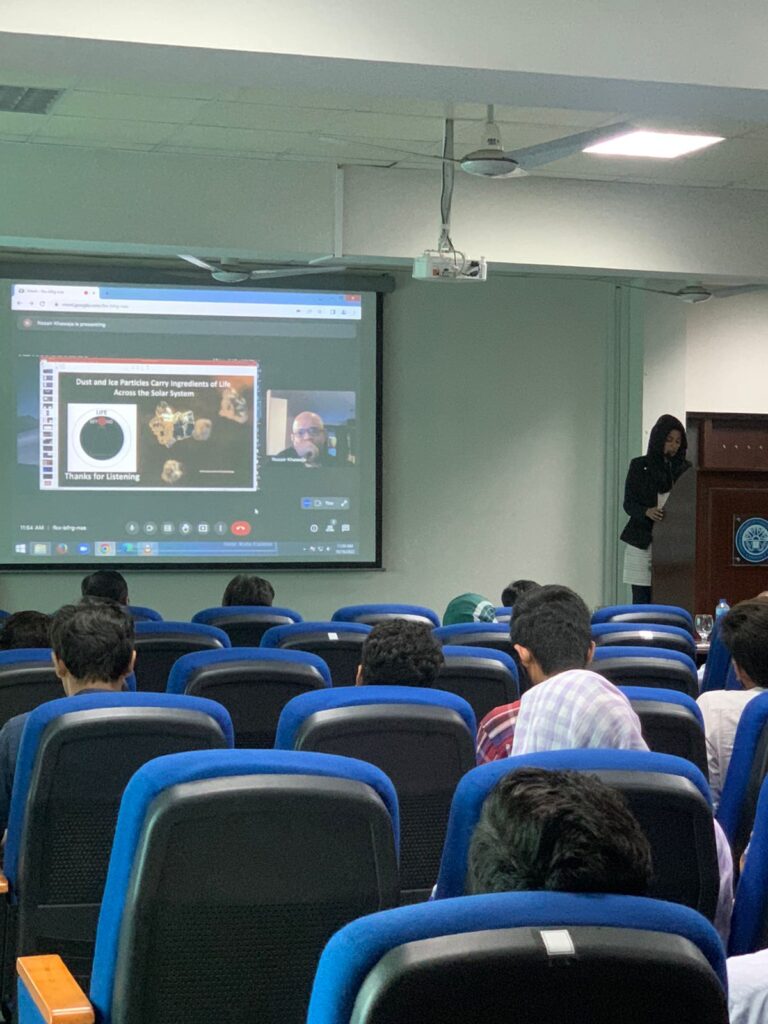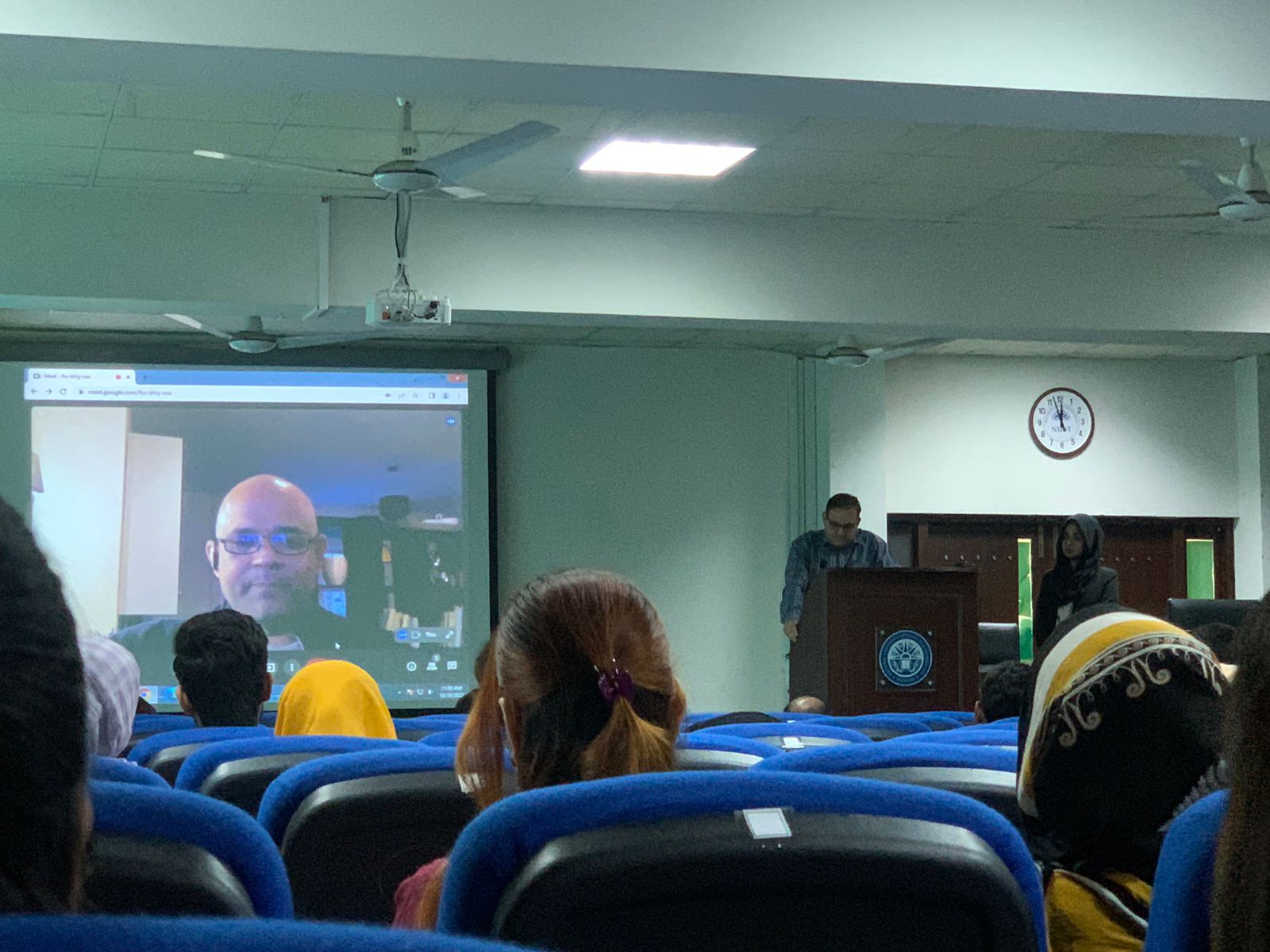Dr Nozair Khawaja, a prominent astrobiologist based in Punjab, now resides in Germany. He has been associated with several space missions like Cassini, Europa Clipper, etc. Dr Nozair’s research papers have been published in Nature and other notable science journals.
Here are some abstracts of his recent talk, which he delivered virtually at the National University of Science and Technology (NUST)
The first question we ask in astrobiology or space exploration is whether humans exist alone in this universe or not. This question is kind of philosophical as well. Other than the interpretation of scientific data, we need to consult the Islamic and religious perspectives of Jews and Christians as well. Since finding life in outer space may have severe implications for our society, we must also keep the repercussions in mind.
To find the answer to whether we are alone in this universe or not, we usually look into two places: our solar system and, beyond it, other galaxies. There are billions of stars and galaxies, thus expanding the potential to search for life.

Since this is quite an expanded field, the question I will mainly focus on is the existence of alien life within the solar system. There is a reason why I did not opt for outer space research. Interestingly, when I went to Finland for my master’s, I went to the observatory in Scandinavia, and the director there asked why I was not interested in research beyond our solar system. I answered that it would be possible within my lifetime only within the solar system because we can at least search eight to nine planets but not beyond that.
When I talk about life within the solar system, I should have some analogues. When we work in the lab, we use a template for analyzing other samples. In this case, our template is the Earth. So, we will compare any life found with the life present here on Earth. So it should be remembered that the study of the earth also comes under the domain of astrobiology.
Before proceeding, you should define what you mean by ‘life’. When I say we will detect aliens within the solar system, what kind are we looking for? So for that, we need to consider the forms of life, i.e., microbial, extremophiles, and life-like humans. If that is not the case, it could also mean there is a second genesis of life that is totally different from our versions of the definition of life, like carbon and hydrogen-based life.
Within the solar system, different space agencies have already sent numerous missions toward the interior solar system that is toward our left, including Mercury and Venus. On our right are the other planets, namely Mars, Jupiter, Saturn, Uranus, and Neptune. There are other species, like comets and asteroids. Humans visit these places extensively to learn about life’s secrets or origins.
The solar system is filled with many dust particles as well. They seem to be pretty useless but are actually of great importance. Many space missions are directed toward icy comets as well. In fact, I am also part of the research team on one such project where I use mass spectrometry in my studies.
Search for life in the outer solar system is useless due to the extremely cold temperatures and lack of water. Searching for life based on our knowledge of life on Earth, we would also expect the presence of water.
Earth comes in the zone where water is liquid, which is a suitable medium for life-related reactions. With some space missions like Aleeno and Casini, we were surprised to know that the solar system also has water in liquid form, particularly on Saturn. One of the moons of Saturn has springs of water erupting from it. That was a fantastic discovery. It changed the paradigm of the habitable zone of the solar system.
Our search for life has now spread all across the solar system. Some moons of Jupiter and Saturn have been shown to have water in liquid form on their surfaces. One of the instruments used in this detection was the ‘gravity instrument’, which measures liquid density variation below the surface.
Saturn’s moon, Enceladus, is really amazing in terms of astrobiology. The three moons of Jupiter are equally important; Saturn has rings made of ice and dust particles. The moons of Saturn, which are more than fifty, are embedded in these rings.
In 2005, by using the magnetometer, scientists discovered that it was deflecting near the Enceladus moon in irregular patterns. An emergency meeting was arranged at the NASA headquarters to organize more space missions toward this particular moon. On the south pole of this moon, enormous jets of water springing from the surface were observed. This discovery shifted the history of space exploration.
The moon has a rocky core with silicate, and water percolates in liquid form on its surface. Hydrothermal reactions occur there. When the water in the land beneath the oceans goes down and gets warmer, it returns to the surface. This is referred to as hydrothermal activity, and we have found it on this moon.
Even after discovering ice grains or dust particles, what are the detection methods for aliens? Basically, dust particles are messengers of life across the universe. The explosion of stars, comets, or asteroids causes dust formation, and some fall on Earth, too.
NASA has set up detectors in the upper atmosphere for these dust particles and collects them as well. In 2016, the research concluded that the ingredients of life might have come to Earth from the solar system. The Earth’s atmosphere blocks meteorites, but they land forcefully on planets with no atmosphere. The dust of these planets is caused to rise for several kilometres.
The ice grains from other planets and moons are helpful. They could carry signs of life if we assume that life is present on those planets. If Enceladus has light present on its surface, how do the light rays enter the ice grains? Whenever you detect light in outer space, you must look at the Earth as the analogue or template. The surface of the oceans on our earth is brimming with countless microorganisms.
When the wind blows, waves are caused on the ocean’s surface. When these waves collapse with each other, air goes into the layers and comes up again, causing bubbles. These bubbles carry microbial life and burst at the surface. Air takes these organic molecules and microbial life up via winds to clouds.
The core has a high temperature on Enceladus, so the fluid comes to the surface via a hydrothermal elevator process and bursts, causing gaseous bubbles. Gas is coming at high speed from under the oceans. It goes into the atmosphere when it comes to the surface.
If microbes are present here, they also go upwards and freeze. We could detect these frozen Mos via space missions in the form of ice grains. I led the research from 2018 to 2019 in which we detected these ice grains. We found signatures of macromolecules with a significant molecular weight of more than 2000 mass per unit value. We classified the material to be like aromatic ring structures, having H and O species as well as saturated and unsaturated sections.
I found very small Bonafede particles in those ice grains as well. Those with a background in organic chemistry will know that these molecules can make amino acids in hydrothermal regions where the temperature is 100 degrees Celsius. The pH is 9, very alkaline, via Friedel-Craft reactions. This was the primary breakthrough research where I just found the building blocks of the protogynous protein structure.
How would you detect these chemicals in the ice grains? The tool we used was mass spectrometry. We look at the cations and anions present. We sent a mass spectrometer to the moon of Enceladus, and it is the most ambitious program of 2024 to be launched.
Another mission is of Japan, heading towards an asteroid because a Japanese agency wants to know whether the dust particles from that asteroid that comes to Earth has a Galmene shower in September or October are it’s or not.
An ambitious mission of Europe was also targeted towards light study with a very interesting instrument. It studied the dust particles near comets. When a dust particle hits a spectrometer, its ions are created, which we detect. This apparatus was part of the Japanese space mission. When I looked at the mass spectrum of the ice grain from space, I observed that it had an aromatic carbon ring structure with hydrocarbon chains that have a difference of 12 to 13 units from each other, meaning they are highly unsaturated. We received a signal of up to 2,000 mass units as well. That’s amazing.
We demonstrated in the lab that we took some fatty acids with C12 to C20. We mixed them based on concentrations that indicate abiotic sources of FAs. We obtained a mass spectrum for the solution and saw that an even number of carbons, i.e., 12 14 16 18 20, had signals equal to C 13 15 17 19. There is no distinction between even and odd-numbered fatty acids.
This solution reflects abiotic features. But then we took the same fatty acids but changed the biotic concentration and saw that the signal of even-numbered C fatty acids is higher than those of odd C FAs. We use this template to tell whether FAs from outer ice grains are from biotic or abiotic sources.
Many advanced studies on extremophiles and electron and UV radiations study mutations in microbes. The moon also has a particular atmosphere. Meteorites land on the surface, and the ice particles enter the instrument of the mission and generate a mass spectrum.
The extraterrestrial ocean world is a potentially habitable place. It means there is either life or favourable conditions to start life. This is exciting!
To sum up, dust particles are basically messengers, and we can tell by their help whether there are aliens in the Solar system.
Also, read: Dr. Nozair Khwaja’s Breakthrough research on Saturn’s Moon, Enceladus.

Aniqa Mazhar is a graduate of QAU in Biochemistry. She has taught sciences to O levels and is currently planning for her MS in Food Technology. Aniqa’s hobbies are reading, watching movies, writing, calligraphy, long walks, and nature photography.

